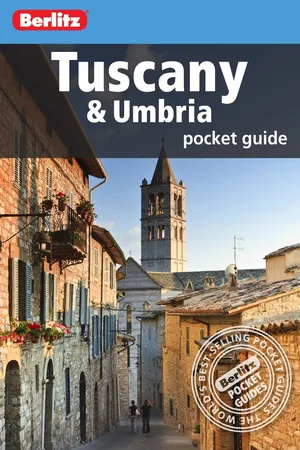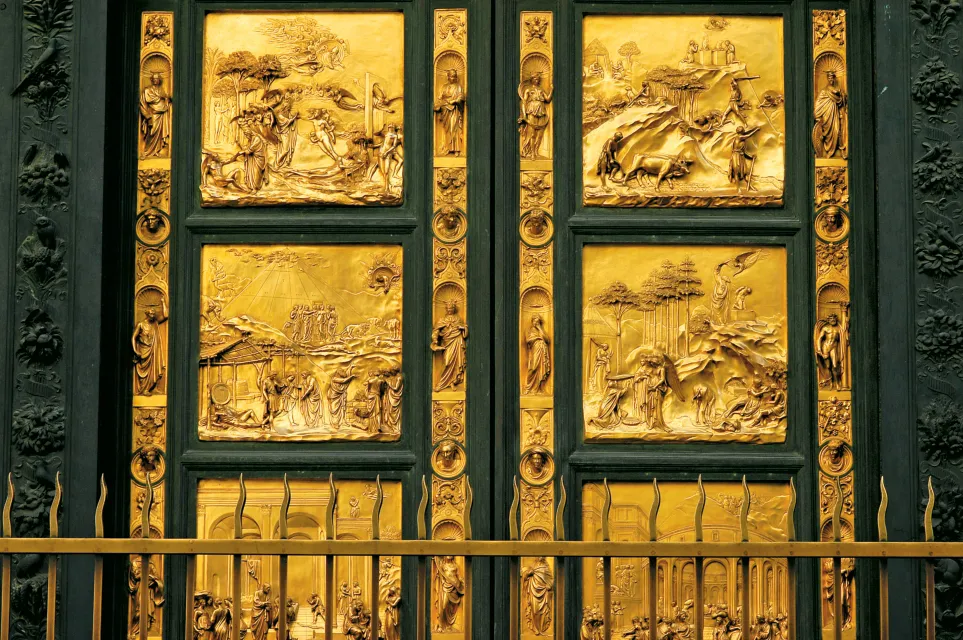When it comes to determining how to plan the logistics of your travels in Tuscany and Umbria, you are both blessed and cursed. For better or worse, and to understate the case, there is just so much to see. Fortunately, the regions are compact enough that you can travel through them with ease, and the road and train networks are excellent.
Statue of Dante Alighieri outside Santa Croce, Florence
Steve MacDonald/Apa Publications
One approach is to divide the regions into sections to be explored in forays from various prinicipal bases. From Florence you can explore Fiesole, Pistoia, Lucca, Pisa and the Chianti countryside to the south, as well as the lesser-known Mugello to the north. From Siena you can follow a spur of the Apennines that separates the central valleys of Italy from the Mediterranean coast, and explore a string of hill towns that include San Gimignano, Volterra and Montepulciano. The centuries-old university town of Perugia is a perfect base from which to set out for Gubbio, Assisi, Spoleto, Orvieto... and the list could go on.
Florence
Florence 1 [map] has been variously described as the most beautiful city in Italy; a ‘city of stone’, imposing and difficult to penetrate; the artistic and humanistic seat of the Renaissance; and one of the most popular tourist destinations in the world. It should come as no surprise, then, that its history is as varied as its current incarnations.
Florence was founded by Julius Caesar as a colony for old soldiers in 59BC, and traces of this orderly era remain in the neat layout of blocks between the Duomo and the Piazza della Signoria. The city muddled through the Roman era as a pleasant backwater, survived the Dark Ages intact, and then, through the wars, revolutions and religious turmoil of the next centuries, began to prosper. Under the generous patronage of the ruling Medici family, sculptors, painters, poets and architects thrived. A surprising number of their works have remained in Florence, kept there by a clause in the will of Anna Maria Ludovica, the last Medici, who in 1743 stipulated that none of the family’s vast holdings was ever to leave Florence. Her wishes have largely been respected, and Florence today provides the visitor with an amazing concentration of the legacy of the remarkable minds of the Renaissance.
Queues form at a doorway on the north side of the Duomo’s exterior to climb the stairs leading to the top of the dome. The summit provides an extraordinary panorama of the city.
All this cultural heritage may sound a bit daunting, but take heart. Sights are close to each other, and all are just a few minutes’ walk from the Piazza del Duomo and its cathedral, the visual and geographic centre of the city.
Subtle changes may be taking place in Florence – more pedestrianised zones, the rejuvenation of the Arno riverbanks – but the city remains the Florence we all know and love.
Piazza del Duomo
The Duomo A [map] (more properly, Santa Maria del Fiore; Mon– Wed, Fri 10am–5pm, Thur 10am–4pm, Sat 10am–4.45pm, Sun 1.30–4.45pm; charge; www.operaduomo.firenze.it) was more than a century in the making. Begun at the end of the 13th century, it was not completed until the late 1460s. The original plans were drawn up by Arnolfo di Cambio, who envisioned the largest cathedral in the world, with an octagonal crossing measuring nearly 46m (150ft) across, to be topped by an enormous dome. Just eight years after construction began, Arnolfo died. A series of architects continued his work, completing the body of the church and the drum for the dome by 1418.
Marble collection – the Baptistery, Duomo and Campanile
Britta Jaschinski/Apa Publications
The architects faced a considerable structural challenge – how to erect a 91m (300ft) high dome over the vast crossing. Into the bickering community of architects and masons stepped fledgling architect Filippo Brunelleschi, who said he could build it, and without using expensive scaffolding, but declined to say how. He was given the job, and confounded sceptics with the elegance of his solution. He designed the dome to be built in two shells of brick, arranged in cantilevered rings so that, as the structure rose, each layer of masonry would support the one above. The Duomo remains one of the masterpieces of the Renaissance, visible from every point in the city, and providing fine views from every angle.
The exterior of the Duomo is clad in patterned marble of three hues – green, white and red – but the overly elaborate facade is actually a 19th-century construct. On the north facade is Porta della Mandorla; its relief, The Assumption of the Virgin, was executed by Nanni di Banco in the 15th century.
The interior is vast, almost austere in its lineaments. The cathedral has accommodated 10,000 worshippers in its bare, grey-and-white interior. Busts of Brunelleschi and Giotto are placed near the entrance. On the wall of the left aisle is a frescoed memorial to Sir John Hawkwood, the English mercenary who was a battle-winning captain of the Florentine army from 1377 until his death; it was painted by Paolo Uccello in the 15th century. Near the end of the aisle is a 15th-century painting by Domenico di Michelino, Dante Explaining the Divine Comedy, in which the Duomo is placed in clear opposition to Hell and Purgatory – a juxtaposition whose meaning must have been clear to a contemporary Florentine. In the right aisle are steps leading down to the old Santa Reperata church, around which the Duomo was built. In 1972 excavators found a funerary slab inscribed with Brunelleschi’s name; it can now be seen through a gate.
The largest work of art in the Duomo is a fresco on the under-side of the dome depicting The Last Judgement; the work was designed by the Florentine architect Giorgio Vasari, executed by his student Frederico Zuccari in the late 16th century, and cleaned and restored in the late 20th. In his design, Brunelleschi added iron hooks to facilitate cleaning and even spaces where canteens were installed for the builders. The gallery provides an excellent vantage point to view seven circular stained-glass windows by Uccello, Castagno, Donatello and Ghiberti.
The Duomo tends to overshadow two other noteworthy buildings on the piazza – the Campanile and the Baptistery. The Campanile (daily 8.30am–7.30pm; charge) is one of the loveliest belfries in Italy. Begun by Giotto in 1334 and finished after his death, it has been hard-hit by atmospheric pollution, and many of its sculptural reliefs are copies. The originals, including works by Donatello, are in the Museo dell’Opera del Duomo. A terrace on top offers a view of the city.
The Baptistery (Mon–Sat 11.15am–7pm, Sun 8.30am–2pm; charge) dates from the 6th century, which makes it the oldest building in Florence. It may originally have been a temple to the Roman god of war, Mars; certainly it was once the city’s main church and the site of a kind of mass baptism every March for all Florentine children born during the preceding year. The building is most famous for its gilded bronze doors, the originals of which are on view in the Opera del Duomo museum.
The Baptistery’s magnificent gilded bronze east doors, the so-called ‘Gates of Paradise’
Steve MacDonald/Apa Publications
The doors on the south were cast in 1336 by Andrea Pisano, who succeeded Giotto in overseeing the Campanile; their 28 compartments depict the story of John the Baptist, p...



